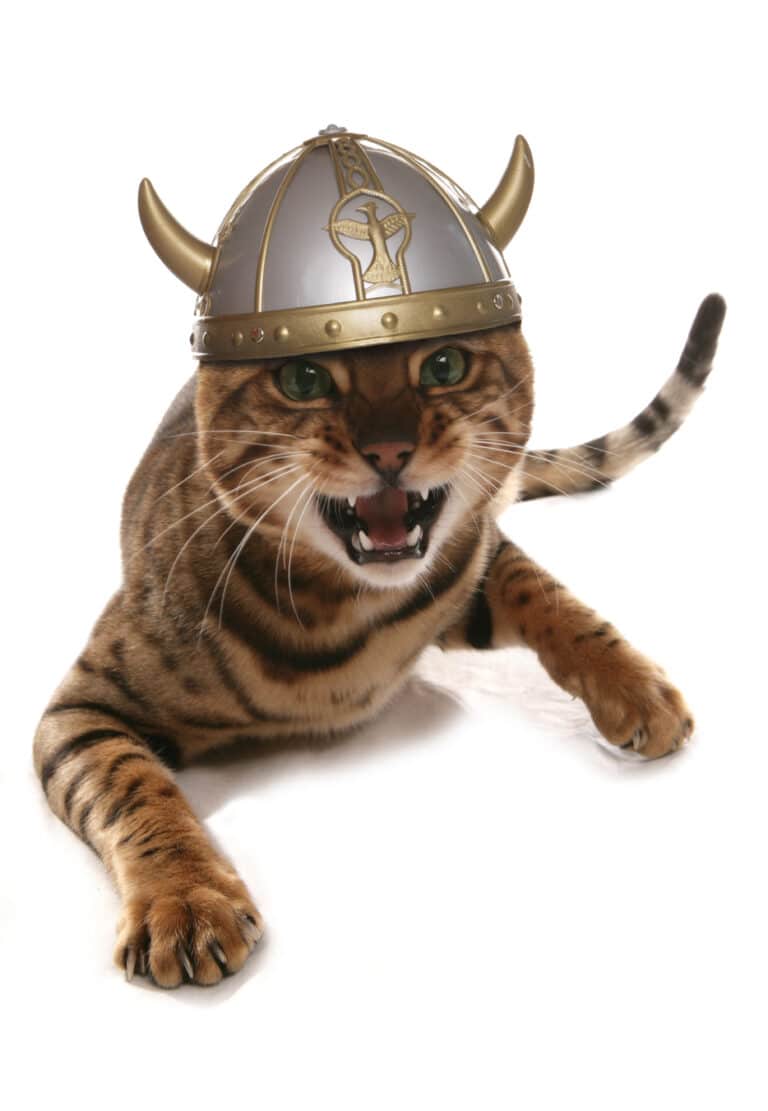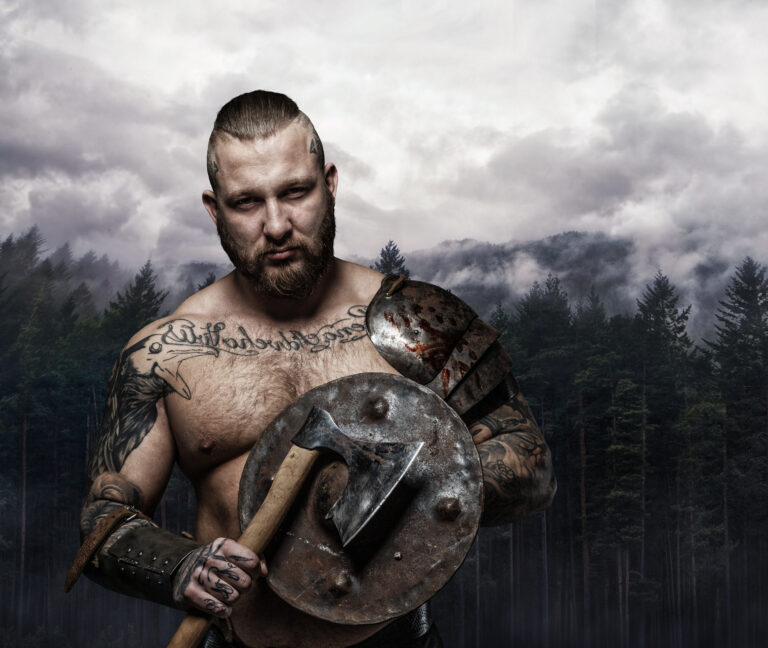What did the Vikings Wear?
This post is going to look at the garments and accessories worn by the people we call vikings. What did vikings wear? Well this post is going to look at what materials norse people had available to them to make clothing. It will also examine what kinds of garments men, and women would wear at home. This might be expected to be different based on social status.
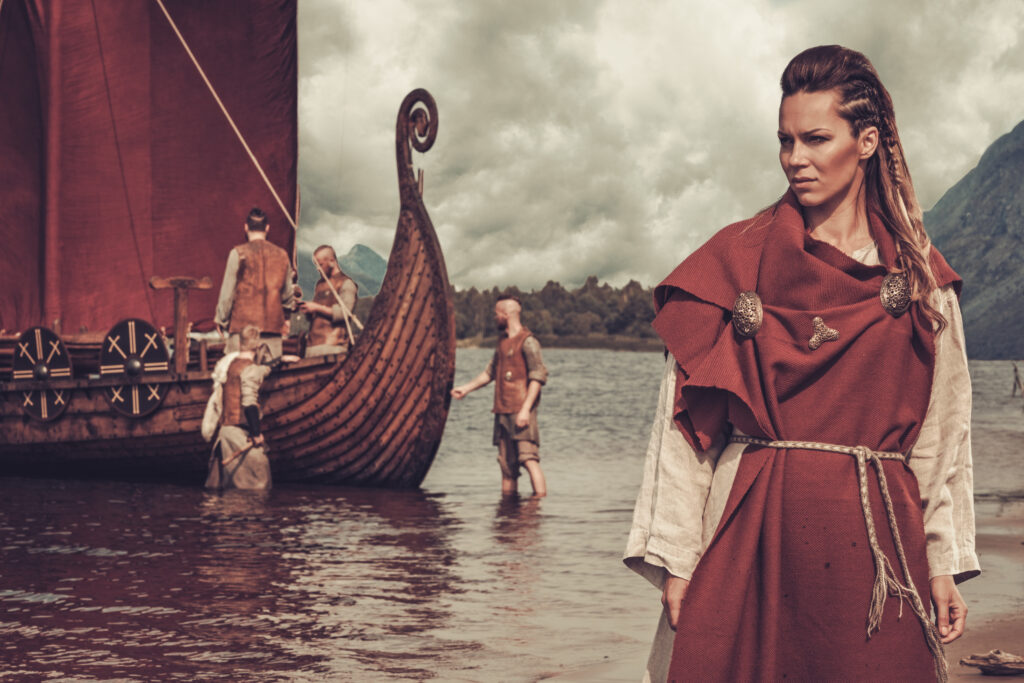
Does anything remain?
Considering the viking period began more than 1300 years ago it might seem shocking that materials still exist. We are so fortunate to have uncovered viking burials that preserved evidence of materials, dyes, and tools. This gives us a ton of information about not only style and status, but trade and availability as well.

Everyday Clothing Available
So first, let’s take a look at what your everyday viking wore. Now remember that we have mentioned many times that viking is actually a verb. Well it is used interchangeably to also just mean the medieval Norse people. So here we are talking about the everyday man and woman living and working on properties in medieval Scandinavia. What kind of archaeological evidence has survived to lend insight into viking fashion?
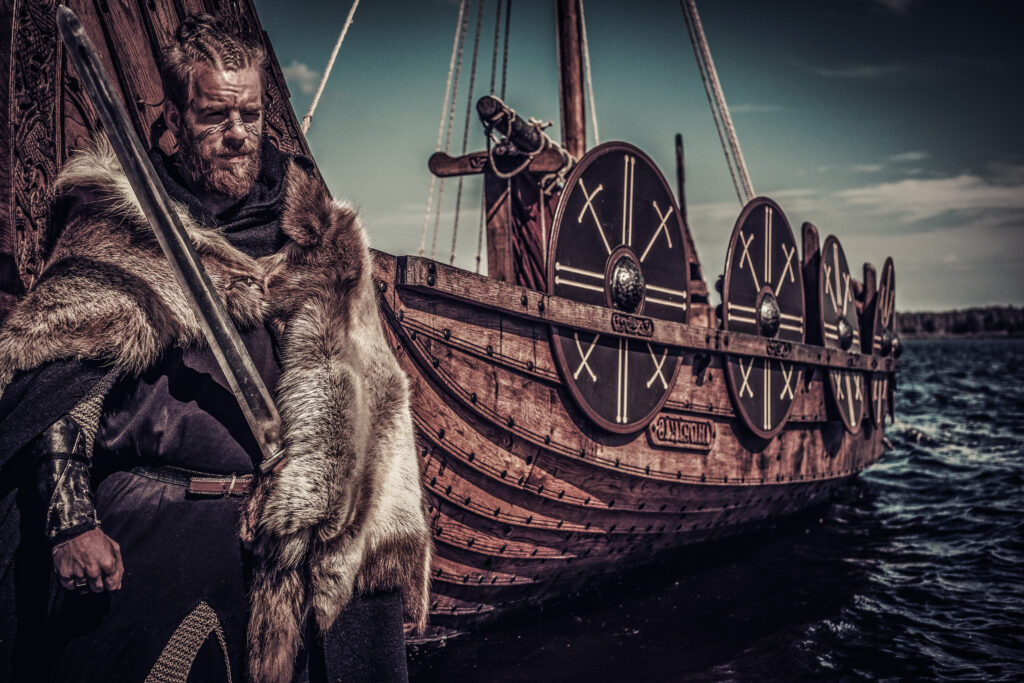
Nettle, Hemp and Flax
Because of time that has passed, we would not expect to find many items of clothing from the viking age. Exploration of viking grave goods have shown more than 100 weaves, made from natural plant fibres. The remnants contained fibres made from nettle, hemp, and flax. The fibres had broken down in the cold, wet graves of Scandinavia. However, they were believed to have come from clothing. Studying these plant fibres or animal fibres give us a great deal of information about everyday life. It is an important cultural link to the past.
Grave Goods Reveal Popular Materials
Grave goods have even revealed what types of feathers from which birds Viking Age Scandinavians used to stuff their pillows. In this instance they used feathers from an Eider, Cormorant, and Gull.
Chamber graves in the medieval Swedish Viking Age town of Birka give us a wealth of information on textiles. Swedish textile scholar Eva Anderson Strand categorized the textile fragments found in graves into four categories
1) Coarse fabrics that were mainly woven
2) Patterned twill fabrics of high quality
3) Ribbed fabrics and other tabby weaves of fine quality
4) Simple twills.
Check out the full article on Viking Age Birka by Eva Anderson Strand here.

Local Clothing Made from Coarse Wool
These fabrics would have been used to create the clothing for viking men and the everyday viking woman. Typical garments might have consisted of long dresses, a long tunic, and strap dresses. This would have required skilled weavers. Strand thinks most of the intricate twill fabrics of high quality were likely imported because of their uniformity. It is theorized that the only fabrics produced in Scandinavia at this time were those of coarser quality.
Textile Evidence in the Sagas
The Icelandic sagas give us some information on what was worn during the Viking era. Tapestry and sails were of great importance and were made locally. The men and women are described as wearing, shirts, cloaks, trousers, shoes, and gloves. Wealthier vikings would have had more opportunity to trade and raid along routes. They would therefore have access to expensive colors, and natural dyes not found in Scandinavia. They may have pieces of jewelry, bright colors, or animal skins that were not local. This would denote higher status in viking society. These good pieces would likely not be for everyday use since acquiring them would be a difficult task.
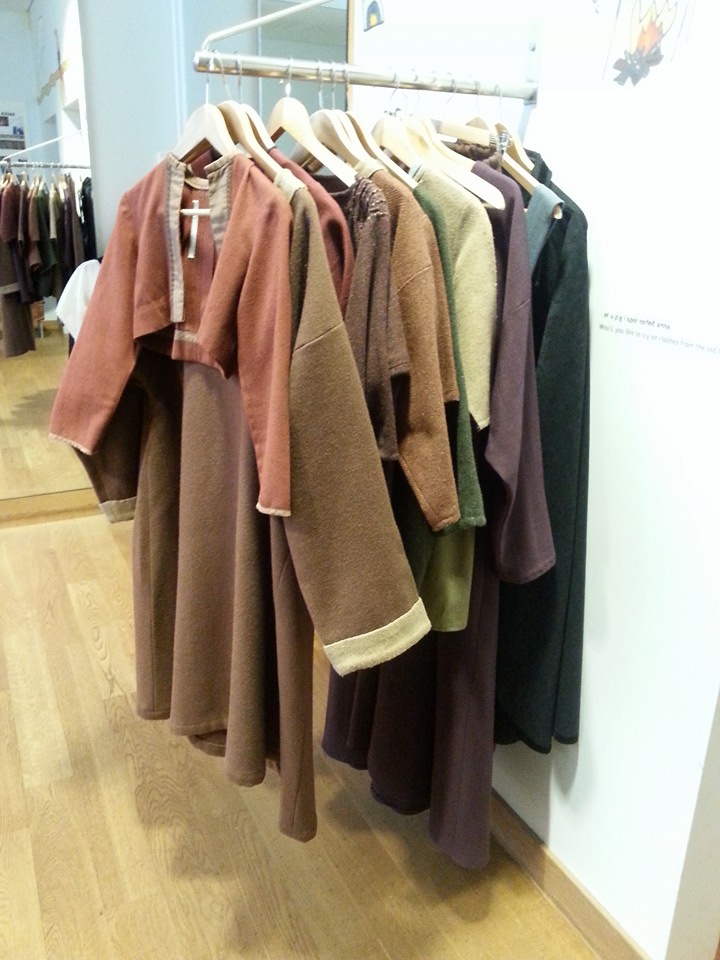
Archeological Finds
Most of the textiles found in the archaeological record are from the social hierarchy. They do not represent ordinary viking clothes, or those of the germanic populations of northern Europe. They denote a higher standing.
In the town of Birka the major raw materials available for the creation clothing were wool and flax. Wool seems to have been the major product used for garment production. It is notable, however, that many other fibres did not survive the elements, so it’s impossible to say with certainty.
The Female Garb
We have both archeological finds, and literature that describe Viking Age clothes. Norse women in Viking Age Scandinavia would typically wear multiple layers. This would consist of a linen shift as an initial layer. It could be smooth, or perhaps pleated. It could also have long sleeves and a long skirt.
Over this layer would be a tunic made of imported silk if they were a woman of high standing. It could also consist of more local materials. This would be held in place by a pair of tortoiseshell brooches.
They may then have worn a shirt over this or a caftan. They would fasten these with trefoil brooches, an equal-armed brooch, or a large round fibula.
In cold weather they would add a cape or a coat closed in the front. They would also typically have leather shoes made from local animal skins.
The Male Garb
A male Scandinavian outfit would include leg wraps, or what we might call leggings today! They might also have wide-flowly, knee-length breeches. Because wool was plentiful it is likely they would have worn a woolen jacket with long sleeves. It might be adorned with simple bronze buttons. A male would likely have a strong leather belt. He would have boots, and he may choose to wear a cap or headgear of some sort.
Class and Style
Just like any other society, you would find men and women who were adorned with finer trim. Aside from the base garments, you might find those who enjoyed woven braids, embroidery, or imported materials.
Long hair is typically believed to be standard for both men and women. We have certainly seen some depictions of vikings with really fantastic hairstyles. Women’s hair is kind of sensationalized, particularly in the media. There have been tiny statues unearthed that actually have some simple double knotted high ponytails, and braids. So hairstyles were not out of the question. But just like the horned helmets, we kind of ran away with this one a little bit.

Available Textiles
Because of the wet weather of Scandinavia, there are not many surviving intact textiles from the Viking Age. We are lucky to have the saga literature that has many rich descriptions of what vikings wore.
Fragments have survived in archeological as well as some of the tools used to produce clothing. Oseberg in Norway (known for the Oseberg ship burial) and York in England have revealed evidence related to textile production. The finds like those mentioned above from Birka also demonstrate the trading, and importance of clothing between 800-1000 CE.
Oseberg Burial Mound
The Oseberg burial mound unearthed in Norway contained the grave of a wealthy viking woman. She was buried with a companion sometimes around the year 834 CE. Found within her grave furnishings were tools used to produce textiles. These including a weaving tablet, with an unfinished braid still attached.
These burials give us such insight into the everyday lives of Scandinavian men and women. They also reveal so much about trade routes of the time. Special dyes, specific animal hides, and medals that could only be found in certain geographic locations. This gives us details of where vikings travelled. We know from certain beads, glasses, and dyes that vikings travelled as far as the Byzantine Empire for trade. Owning these items would be a status symbol.
Check out more about textiles in this article: Identifying plant fibre textiles from Norwegian Merovingian Period and Viking Age graves: The Late Iron Age Collection of the University Museum of Bergen
Bundled Up in Blue
I was fortunate enough to get a glimpse of some of these authentic viking finds. During my years in Iceland the National Museum had a display of a female viking burial. In 1938 some road workers in North Eastern Iceland discovered the remains of a viking age burial. The museum randomly came across a jar of fromaldhyde with remanents of a jawbone and intact flesh. It was discovered to be from this burial and a proper examination of the grave goods was conducted.
Mineralization Preserves Materials
The exhibit was titled “Bundled Up in Blue” and showcased many of the items we’ve spoken about above. The flesh was actually preserved because when the female was laid on her side. Her cheek rested on the oval brooch. It was the brooch’s metal (copper alloy) that reacted with the flesh and helped preserve it. Aside from the brooches she was buried in, the grave also contained other items. There was a trefoil brooch, 42 beads, textile fragments, and two whetstones. There was also, bone fragments that may have been a comb or a knife handle. A spindle whorl, and a blue stone of unusual shape which proved to be a fragment of chalcedony.

Social Status
This woman held a higher social status than most. The copper alloy brooches were gilded with silver. It is theorized that brooches might have been a symbol of marriage. They are found uniformly across most female viking graves. So much so, that even when sex is indeterminable they use brooches to say it is a female grave. But females graves have been found without them. There is a link to age in these cases. This suggests the younger women may not have been married and therefore did not wear brooches yet. They are also shaped like breasts and wore on or right above the breast. Brooches are also thought to perhaps represent feminity, lactation, ot sexuailty. They may have also been a symbol of the goddess Freya.
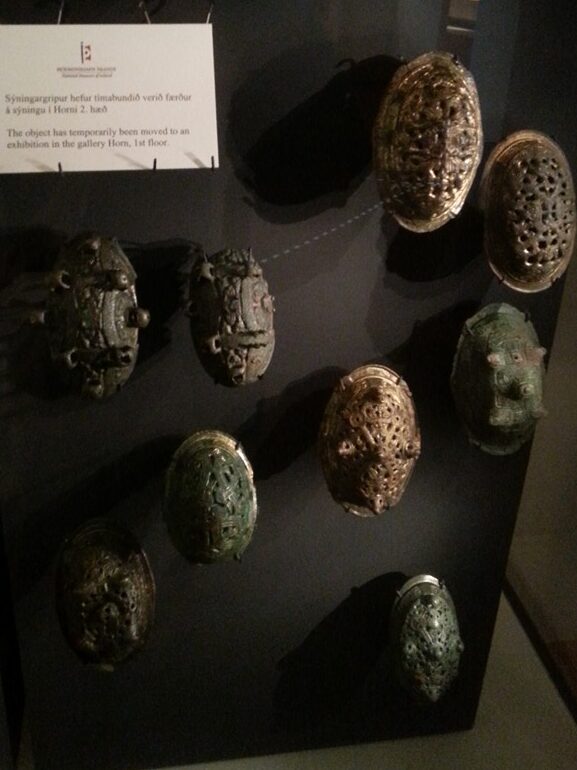
Textiles rarely survive. However, the same mineralization process that preserved part of her flesh also preserved several of her dress fragments. Mineralized linen and wool fibres have survived. One piece was dyed blue and might have been a part of a long dress or shift. Therefore, the surviving fabric also demonstrated weaving abilities.
You can learn more about the Bundled Up in Blue Exhibit. Check out this link: The Lady in Blue-Bláklædda Konan: the textiles. National Museum of Iceland.
Clothing was Diverse
The vikings had access to many trade routes. Therefore, it is expected that they would have unique items from all over the world. When we ask – what did the vikings wear, we have to consider access. They had access to beads, dyes, fibres, clothes that were not native to Scandinavia. Viking warriors would raid, or trade and bring back exotic items. Again, that is why they are found in what are usually deemed affluent graves.
It was diverse, but likely nothing like what we see in tv shows like Vikings. This sensationalizes the warrior aspect. Most of the year vikings were simply farmers and fishermen, trying to make ends meet. What did viking wear? Well, their wardrobes were pretty diverse, in the same way ours are now.
Check out more Viking FAQ like: Were the Vikings from Iceland right here!



